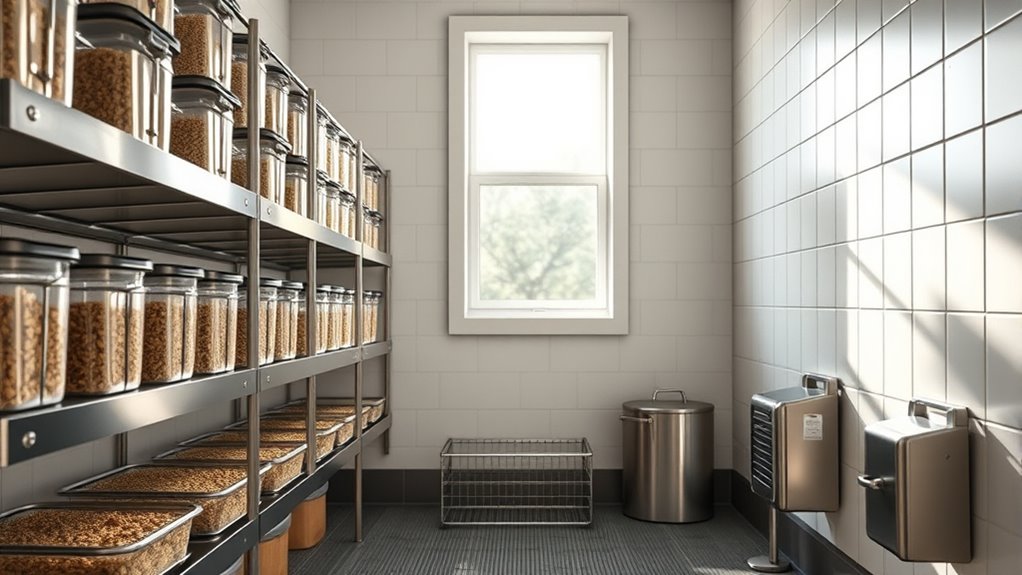To reduce rodent pressure in feed rooms during October, start with a thorough inspection to spot entry points and signs of activity. Seal gaps using durable materials, and keep the area clean with proper waste management and sanitation. Set up bait stations and traps along walls and dark corners, and maintain surrounding vegetation by trimming weeds and debris. Regular monitoring and staff education are key. Keep exploring for more strategies to keep your feed room rodent-free.
Key Takeaways
- Conduct thorough inspections to identify and seal all entry points using durable materials like steel wool and caulk.
- Implement strict sanitation by cleaning daily, storing feed in airtight containers, and removing spilled feed promptly.
- Set bait stations and traps along walls and dark corners, checking and refilling them regularly for continuous effectiveness.
- Trim surrounding vegetation and remove debris near feed areas to eliminate rodents’ hiding and nesting spots.
- Train staff on pest signs, reporting procedures, and routine maintenance to ensure proactive rodent management in October.
Conducting a Thorough Inspection of Your Feed Room
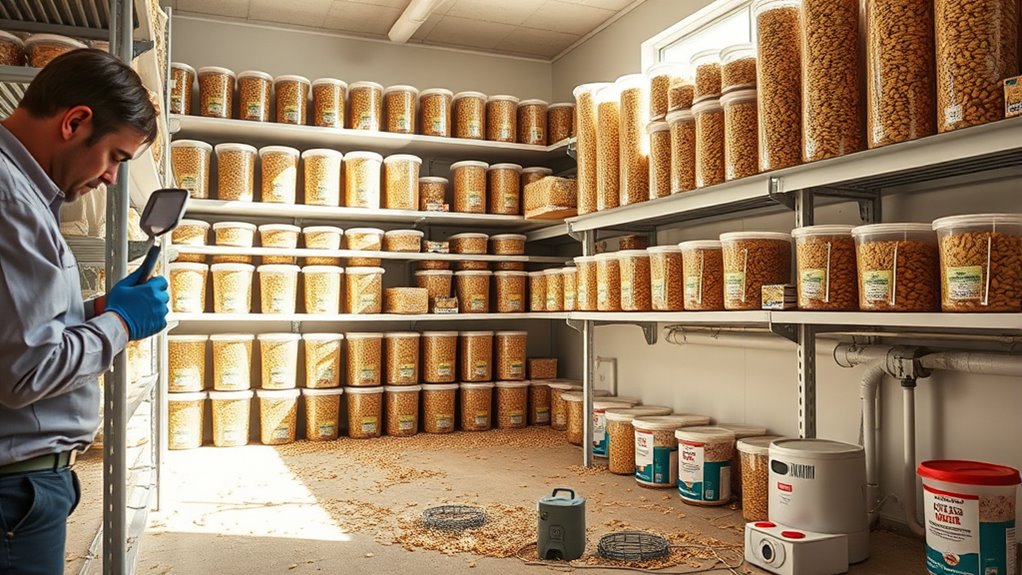
Before taking any steps to control rodents, you need to thoroughly inspect your feed room. Understanding rodent behavior helps you spot entry points, nesting sites, and signs of activity. Look for droppings, gnaw marks, and shredded packaging, which indicate recent rodent presence. Pay close attention to areas where feed is stored; improper feed storage techniques can attract rodents. Ensure all containers are airtight, sealed, and elevated off the ground. Check for gaps around doors, windows, vents, and utility penetrations—these are common entry points. Also, examine walls and corners where rodents often hide and travel. A detailed inspection reveals vulnerabilities in your feed storage setup, allowing you to address problem spots before an infestation worsens. Properly understanding rodent behavior is key to effective prevention. Additionally, implementing tuning modifications in your feed room environment, such as sealing entry points and improving storage practices, can significantly reduce rodent activity. Incorporating advanced inspection techniques, such as using UV light to detect droppings or motion-activated cameras, can also enhance your ability to identify early signs of infestation. Being aware of pinball machine weights can help in planning for safe and effective cleaning or maintenance of your facility to prevent damage or injury. Recognizing patterns of rodent movement can aid in predicting their behavior and targeting control measures more effectively.
Implementing Effective Sanitation Practices
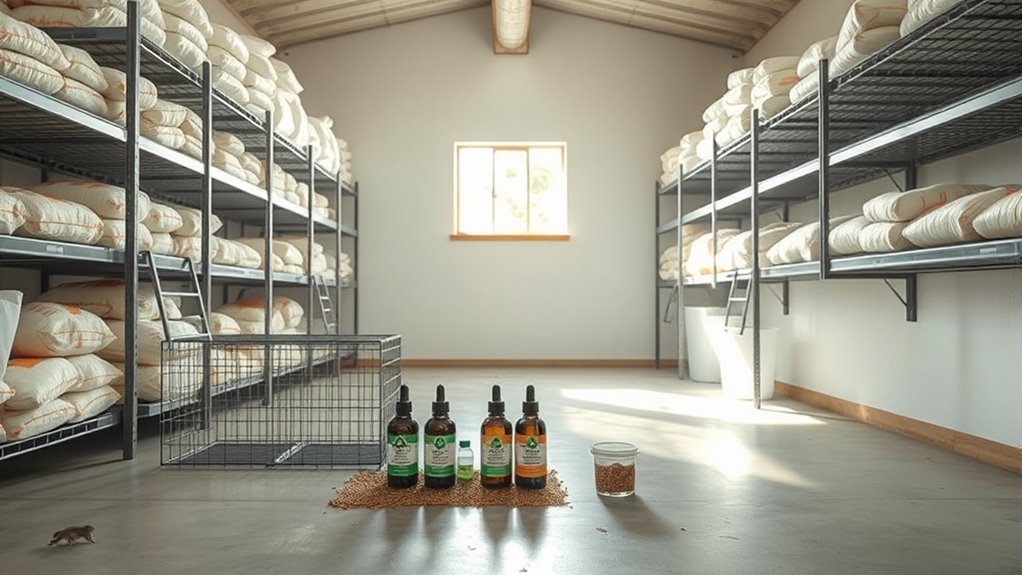
You can reduce rodent problems by sticking to a regular cleaning schedule that keeps your space tidy. Proper waste management prevents attractants, and maintaining equipment guarantees there are no hiding spots. Implementing these sanitation practices creates an environment rodents want to avoid. Incorporating seasonal events and promotions can also help keep your feed room monitored and clean. Additionally, maintaining proper sanitation ensures consistent removal of potential food sources and nesting materials, further discouraging rodent activity. Using self-watering plant pots to grow deterrent plants like mint or lavender can provide an additional natural barrier against rodents, especially during extended hours when monitoring might be more challenging. Regular inspection and rodent-proofing measures are vital in maintaining a pest-free environment.
Regular Cleaning Schedules
Establishing a consistent cleaning schedule is essential for reducing rodent attraction and harboring. Regularly cleaning feed rooms removes crumbs, spills, and debris that draw pests. Use pest proof containers to store feed securely, preventing easy access. Ensuring all supplies are stored on rodent proof shelving minimizes hiding spots. Schedule daily sweeping and wiping of surfaces, especially around storage areas. Also, inspect and clean behind equipment and walls weekly. Proper sanitation disrupts rodent nesting habits and discourages infestation. For added protection, consider using Pimple Patches as part of a comprehensive pest control strategy, targeting specific problem areas. Maintaining cleanliness standards is crucial in deterring rodents and keeping your feed room pest-free. Consistent sanitation not only prevents pests but also supports overall biosecurity in your operation. In addition, implementing effective sanitation practices can significantly reduce the likelihood of a rodent problem developing. Here’s a suggested cleaning routine:
| Task | Frequency |
|---|---|
| Sweep floors and shelves | Daily |
| Disinfect storage areas | Weekly |
| Check and clean pest proof containers | Weekly |
| Inspect and organize storage | Monthly |
Proper Waste Management
Effective waste management is vital for reducing rodent attraction, as discarded food and waste materials provide easy food sources for pests. You should regularly manage your compost bin to prevent odors and eliminate food scraps that draw rodents. Proper compost bin management involves turning compost regularly and keeping lids secure. Implementing proper sanitation practices ensures that waste does not become a haven for pests. Practice strict waste disposal procedures by promptly removing trash from feed rooms and sealing waste containers tightly. Avoid overfilling bins and ensure they are cleaned regularly to prevent residue buildup. Discarded feed spills and leftover food can quickly attract rodents, so immediate cleanup is essential. Maintaining a tidy environment by following effective waste disposal procedures minimizes pest attraction. Regular staff training on waste handling can prevent accidental spillage and further reduce rodent risks. Additionally, understanding pest behavior can help in designing more effective waste management strategies. Incorporating behavioral cues such as visual reminders can reinforce good waste management habits among staff. By controlling waste effectively, you considerably reduce the likelihood of rodent infestations in your feed room.
Equipment Maintenance Strategies
Implementing effective sanitation practices is essential for maintaining equipment that resists pest attraction and contamination. Regularly calibrate equipment to ensure peak performance and prevent pest-friendly malfunctions. Proper tool lubrication keeps machinery running smoothly, reducing the risk of debris buildup that can attract rodents. To keep equipment pest-free, focus on:
- Scheduling routine calibration checks for all machinery
- Applying appropriate lubrication to moving parts
- Cleaning equipment thoroughly after each use
- Staying informed about pest management strategies to adapt your maintenance routine effectively
- Keeping equipment hygienic is crucial for preventing rodent infestations and maintaining a safe feed environment. Additionally, implementing preventive maintenance protocols can further reduce the likelihood of pest issues. Maintaining clean and well-maintained equipment also reduces pest hiding spots, making your feed room less appealing to rodents. Regular inspections can help identify potential entry points and rodent attractants, enabling prompt action to mitigate risks. Consistent maintenance minimizes the chances of pests contaminating feed supplies and promotes hygienic operations. By staying diligent with calibration and lubrication, you create a cleaner, safer environment that discourages rodent activity and supports overall pest management efforts.
Sealing Entry Points to Keep Rodents Out
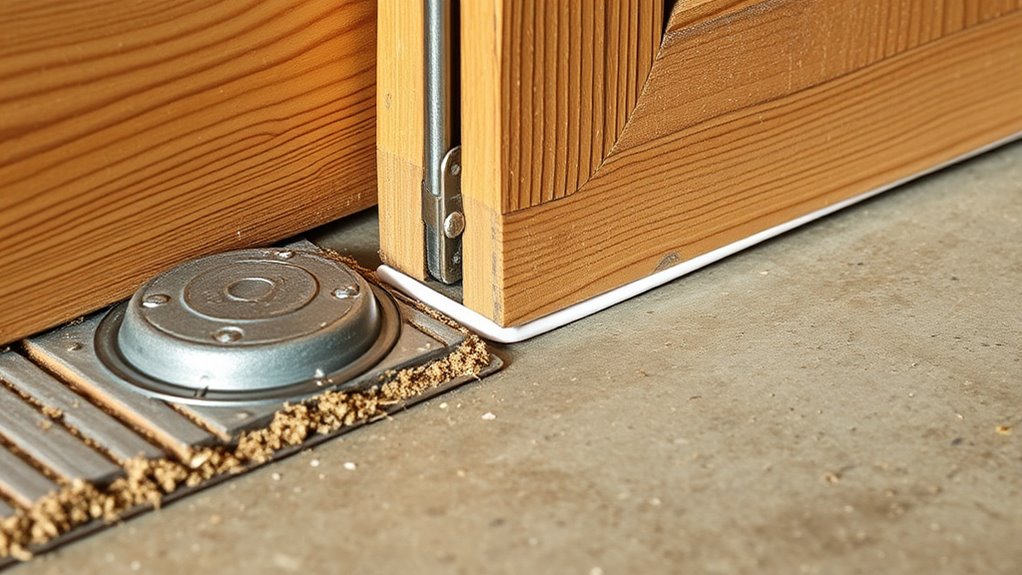
You can prevent rodents from entering by carefully inspecting your home for gaps and cracks. Seal these openings using durable materials that rodents can’t chew through. Taking these steps creates a strong barrier and reduces the chances of an infestation.
Inspect and Seal Gaps
Inspecting your home for gaps and entry points is the crucial first step in keeping rodents out. You need to identify all potential access points, no matter how small. Use a flashlight to peek behind appliances, in corners, and along baseboards. Once located, apply effective rodent proofing techniques by sealing these gaps with appropriate gap sealing materials. Focus on areas like utility holes, vents, and door frames. Consider the following:
- Fill larger holes with steel wool or hardware cloth
- Seal small cracks with caulk or foam sealant
- Use metal flashing around pipes and vents
These steps prevent rodents from squeezing through tiny openings. Regular inspections and prompt sealing are essential for maintaining a rodent-free environment. Proper gap sealing materials ensure your barriers are durable and effective.
Use Durable Materials
To effectively block rodent entry points, choosing durable sealing materials is essential. Using resilient materials ensures your seal lasts against gnawing and weathering, maintaining rodent proof construction over time. Materials like steel wool, metal sheets, and high-quality caulk create a strong barrier that rodents can’t chew through or bypass. Avoid flimsy products that quickly degrade or become ineffective. Properly sealing all gaps, cracks, and holes with these tough materials prevents rodents from finding hidden entry points. Focus on areas around pipes, vents, and foundation walls, where rodents are most likely to squeeze through. Investing in durable materials not only saves you time and effort but also provides a long-term solution for keeping rodents out of your feed room.
Setting Up Strategic Bait Stations
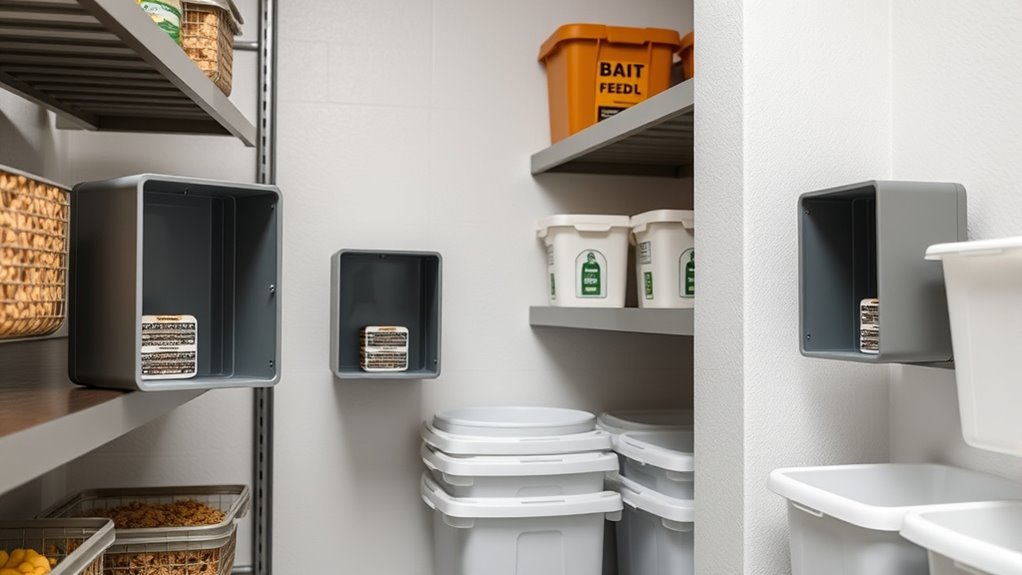
Setting up strategic bait stations is essential for effectively controlling rodent populations. Proper bait station placement ensures rodents find and use them consistently. Position stations along walls, near entry points, and in dark, hidden areas where rodents travel. Use rodent attractants like food scents or odor-based lures inside the stations to draw them in. Keep stations elevated off the ground to prevent accidental contact and tampering. Regularly check and refill bait to maintain effectiveness, especially if weather or activity levels change. Remember, the goal is to make bait stations accessible yet secure, encouraging rodents to feed without risking unintended exposure. When placed correctly and stocked with the right attractants, bait stations become a powerful tool in your rodent control plan.
Utilizing Traps for Quick Population Control
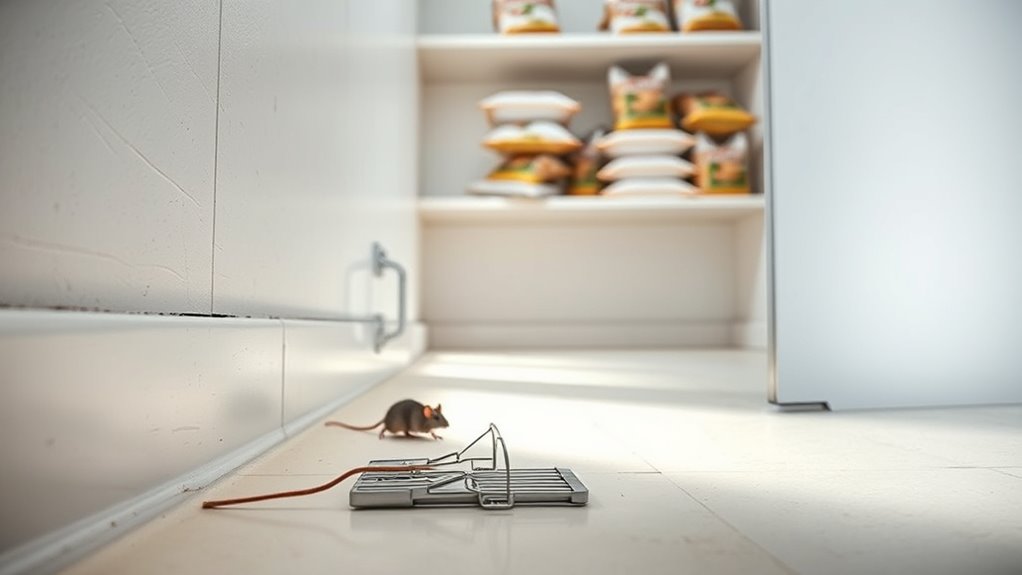
When you need rapid results in rodent control, traps offer an effective way to quickly reduce populations. Choose the right trap types, such as snap traps or electronic traps, based on your needs. Place traps strategically around the feed room, focusing on known rodent pathways and near walls, where mice and rats prefer to travel. Proper bait station placement is vital; use attractive baits like peanut butter or grains and secure them firmly to prevent tampering. Regularly check traps and replace bait to maintain effectiveness. Using a combination of trap types and strategic placement helps you quickly target active rodents and prevent infestations from worsening. Traps provide immediate results and are essential for swift population control in feed rooms.
Managing Vegetation and Surrounding Areas

Managing vegetation and surrounding areas is essential for preventing rodent entry and harboring. By controlling vegetation, you reduce hiding spots and eliminate pathways rodents use to access feed rooms. Focus on maintaining a clear buffer zone around structures to limit the surrounding habitat that attracts pests.
Consider these steps:
- Regularly trim grass and remove weeds to reduce cover for rodents.
- Remove piles of debris, wood, or dense shrubbery near feed storage areas.
- Use vegetation control to keep trees and bushes away from building walls and vents.
Keeping the area tidy and well-maintained cuts down on potential nesting sites, making it harder for rodents to establish themselves. A clean, well-managed environment is key to effective rodent prevention.
Monitoring and Maintaining Rodent Control Measures
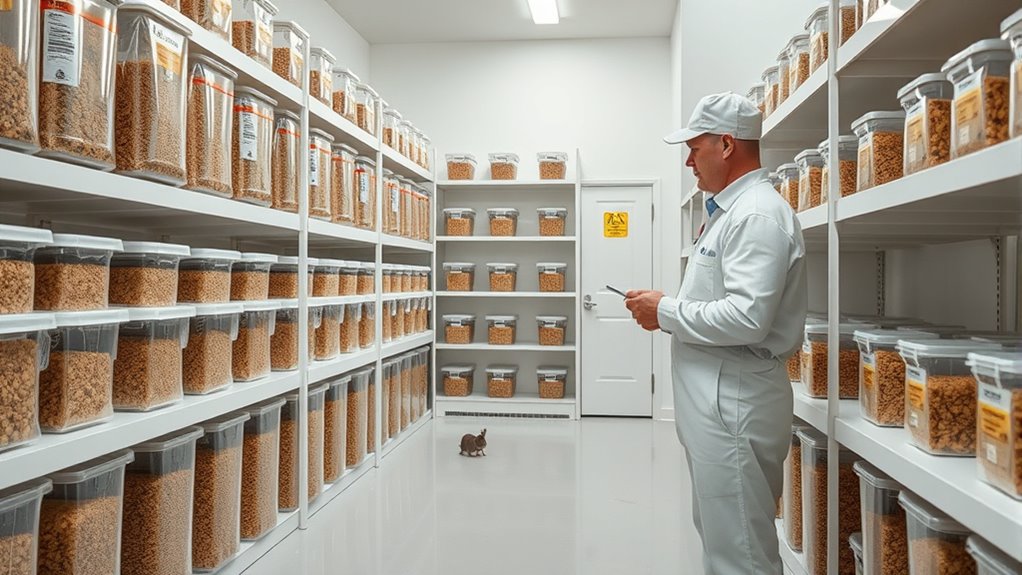
Regularly monitoring your rodent control measures helps guarantee they remain effective over time. Observe rodent behavior to identify signs of activity, such as droppings or gnaw marks, and check traps or bait stations regularly. Understanding how rodents adapt their habitat allows you to detect new entry points or changes in their movement patterns. Maintain your control devices by replacing bait and repairing any damaged barriers promptly. Consistent monitoring ensures you’re addressing current rodent activity and preventing new infestations. Keep detailed records of inspections and results to spot trends and adjust your strategies accordingly. Staying vigilant helps you catch issues early and maintain a rodent-free environment, reducing the risk of contamination and damage in your feed room.
Educating Staff and Developing a Prevention Plan
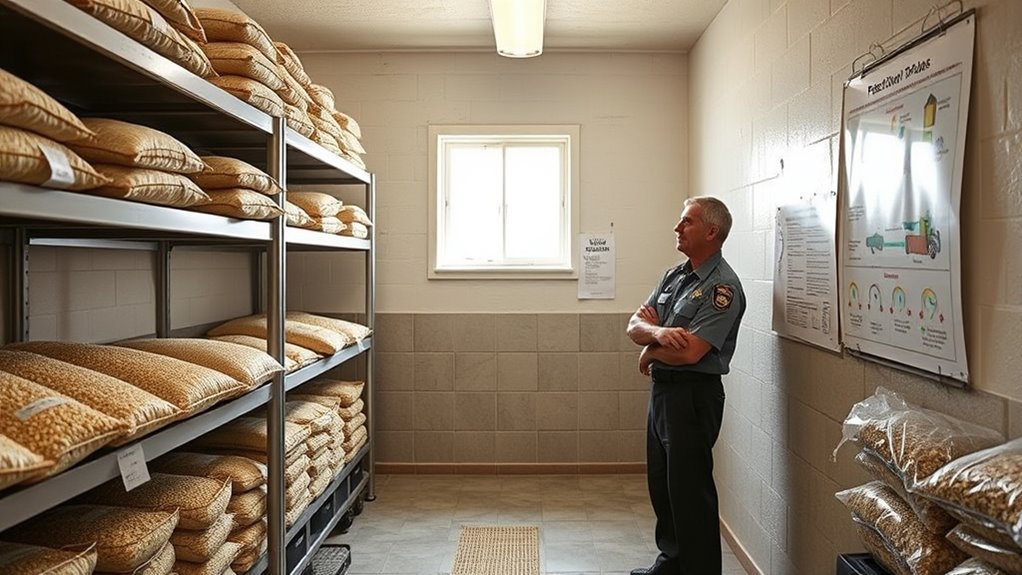
Educating staff and developing a prevention plan are essential steps in maintaining an effective rodent control program. Proper staff training helps everyone recognize signs of rodent activity and understand their role in prevention. A solid prevention plan guarantees consistent practices, reducing entry points and attractants.
Consider these key actions:
- Conduct regular staff training sessions on rodent identification and reporting procedures
- Establish clear guidelines for sanitation and waste management
- Create a thorough prevention plan that outlines inspection routines and corrective actions
Frequently Asked Questions
How Often Should I Reassess My Rodent Control Strategies?
You should reassess your rodent control strategies regularly to stay effective. Typically, conduct inspections at least monthly to identify new signs of rodent activity. If you notice an increase, update your strategies immediately. Consistent inspection frequency helps catch problems early, while strategy updates guarantee your methods remain effective against evolving rodent behavior. Staying proactive keeps your feed rooms protected and minimizes damage caused by rodents.
Are Natural Deterrents Effective in Reducing Rodent Activity?
Natural repellents can be somewhat effective, but their overall effectiveness of deterrents varies. You might notice temporary relief, yet rodents often adapt quickly, reducing long-term success. It’s best to combine natural deterrents with other control methods like sealing entry points and removing food sources. Relying solely on natural repellents may not fully resolve the problem, so reassess your strategies regularly for the best results.
What Are Signs of a Hidden Rodent Infestation?
You might think a rodent infestation is obvious, but the signs of infestation can be sneaky and easily overlooked. Look for gnawed wires, droppings the size of rice grains, and unusual greasy trails. Unseen rodent presence often leaves subtle clues like shredded packaging or tiny holes in walls. Stay vigilant—these signs can hide behind walls or inside ceilings, making the infestation seem invisible until it’s almost too late.
How Does Weather Impact Rodent Control Efforts?
Weather profoundly impacts your rodent control efforts. During colder months, rodents seek seasonal shelter indoors, making it harder to detect and eliminate them. High moisture levels from rain or humidity also attract rodents, as they seek water sources. To improve control, focus on moisture management by fixing leaks and reducing clutter, and seal entry points to prevent rodents from finding shelter in your building. Stay vigilant year-round for the best results.
Can Certain Feed Storage Methods Prevent Rodent Access?
Like a fortress guarding treasure, certain feed storage methods can prevent rodent access. Using airtight, rodent-proof containers seals off entry points, while elevated storage keeps feed away from ground burrows. Properly maintained, these strategies create barriers that deter rodents, making feed storage more secure. By implementing these rodent prevention techniques, you reduce the risk of contamination and damage, ensuring your feed remains safe and accessible.
Conclusion
By following these steps, you create a fortress that rodents can’t breach. Regular inspections and sanitation keep your feed room secure, while strategic baiting and trapping act as your frontline defenses. Remember, prevention isn’t a one-time effort—it’s an ongoing battle. Stay vigilant and proactive, because the only thing worse than a rodent infestation is the thought of what it could become if left unchecked. Don’t wait—act now, or face the consequences of neglect.

